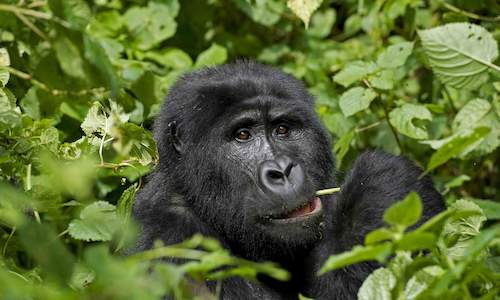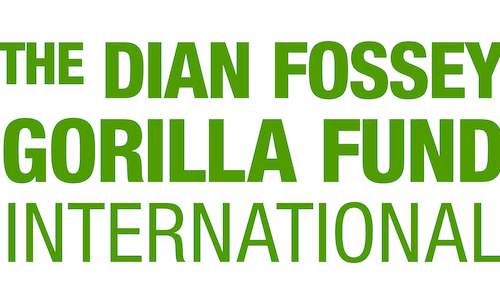Dian Fossey
The greatest champion of Gorilla conservation was Dian Fossey who's pioneering work laid the basis for much of our understanding of these endangered animals.Early life
Dian Fossey was born in San Francisco in the United States in 1932. Her parents divorced when she was still young and she grew up with her mother and stepfather. She was a good student and was interested in animals from an early age. However at college she studied business as this is what her step father encouraged her to do.
Fossey eventually attained a degree in occupational therapy from San Jose State College in 1954. Throughout her jobs, Fossey dreamed of going to Africa and seeing more of the World's wildlife. After saving up for many years and taking out a loan that was the equivalent of a year's salary, in 1963 she went on a 7 week tour of Africa.
Travel to Africa and meeting Dr. Loius Leakey
She arrived in Kenya and toured Tanzania, Congo and Zimbabwe. Her guide was a British hunter called John Alexander. The two final destinations on their African tour included the Olduvai Gorge in Tanzania - the archeological site of Louis and Mary Leakey and Mt. Mikeno in the Congo, where the American zoologist George Schaller has carried out a pioneering study on the Mountain Gorilla.
Fossey then encountered her first Gorilla on October 16th in the Virunga Mountains in Uganda. Fossey stated in Gorillas in the Mist that:
"It was their individuality combined with the shyness of their behaviour that remained the most captivating impression of this first encounter with the greatest of the great apes. I left Kabara with reluctance but with never a doubt that I would, somehow, return to learn more about the gorillas of the misted mountains."
Both these encounters laid the foundation for what was to become Dian Fossey's life work. Dr Louis Leakey spoke to Fossey about Jane Goodall's work with Chimpanzee's in Tanzania, and his belief in long term studies on Gorillas in their natural habitat. In Gorillas in the Mist Fossey states that "I believe it was at this time the seed was planted in my head, even unconsciously, that I would someday return to Africa to study the Gorillas of the mountains."
Travel to Africa and meeting Dr. Loius Leakey
She arrived in Kenya and toured Tanzania, Congo and Zimbabwe. Her guide was a British hunter called John Alexander. The two final destinations on their African tour included the Olduvai Gorge in Tanzania - the archeological site of Louis and Mary Leakey and Mt. Mikeno in the Congo, where the American zoologist George Schaller has carried out a pioneering study on the Mountain Gorilla.
Both these encounters laid the foundation for what was to become Dian Fossey's life work. Dr Louis Leakey spoke to Fossey about Jane Goodall's work with Chimpanzee's in Tanzania, and his belief in long term studies on Gorillas in their natural habitat. In Gorillas in the Mist Fossey states that "I believe it was at this time the seed was planted in my head, even unconsciously, that I would someday return to Africa to study the Gorillas of the mountains."
First Encounters
Fossey then encountered her first Gorilla on October 16th in the Virunga Mountains in Uganda. Fossey stated in Gorillas in the Mist that:
"It was their individuality combined with the shyness of their behaviour that remained the most captivating impression of this first encounter with the greatest of the great apes. I left Kabara with reluctance but with never a doubt that I would, somehow, return to learn more about the gorillas of the misted mountains."
Fossey had to return to the United States and work to pay off the loan she had used to fund her trip. However, she published a few articles about her encounter with the Gorilla and when Leakey came and did a lecture in Kentucky; he spoke to Fossey about the possibility of her heading up a long term field project studying the Gorillas.
It took 8 months for them to secure the funding that they needed and in this time Fossey paid off her loan and learnt Swahili. In December 1966 Dian left for Africa. She met Jane Goodall and spent some time observing her research methods with the Chimpanzee's.
Kabara
In early 1967 Dian set up her camp in the Virungas at Kabara and Fossey started studying the Gorillas. Fossey lived a very rustic existence with nothing but a small tent. An experienced tracker Sanweke joined her and taught her how to track the Gorillas. They eventually identified three Gorilla groups in her study area.
Initially the gorillas would flee when she came upon them, but over time Fossey was able to gain their acceptance. Fossey used to imitate their regular activities, by scratching and pretending to forage. She was able to start identifying individuals. She started learning a lot about Gorilla behaviour.
The political situation in Zaire was deteriorating and she was put under military guard until she was able to orchestrate her escape to Uganda. Against much advice she decided to continue her work on the Rwandan side of the Virungas.
Founding the Karisoke Research Centre
In 1967 Fossey founded Karisoke Research Centre which would eventually become an internationally renowned research station. Fossey successfully habituated six groups of Gorillas in the Kabara region. In 1968 the National Geographic Society sent photographer Bob Campbell to photograph her work. Initially she felt that this was an intrusion, but they became friends and his photographs made Fossey a celebrity. They showed the gorillas as gentle creatures, different from the violent images portrayed in movies. The pictures drew attention to their plight.
Though she took extensive notes Fossey often did not feel up to the scientific aspects of studying the Gorillas as she did not have the credentials so in 1970 she enrolled in the department of animal behaviour at Darwin College Cambridge under Dr Robert Hinde, who had also been Jane Goodall's supervisor and in 1974 completed her Ph.D. This also allowed her to get more funding.
Anti-poaching and conservation efforts
Dian became increasing concerned about the threats Gorillas faced from poachers and cattle herders. They often got caught in traps and the cattle encroached on the Gorillas habitat. He took to many unorthodox methods to deter poachers and this made her very unpopular in the region. She used her own funds to help the park guards enforce the anti-poaching laws. This spawned the first Karisoke anti-poaching patrols to protect the Gorillas in the research area.
Digit
During the course of her research Fossey formed a close bond with one particular Gorilla called Digit. On December 31, 1977 he was killed by poachers while trying to protect his group. It was then that Fossey declared war on the poachers. Digit had been part of the photos Bob Campbell took and had a celebrity status of his own and Fossey used his death to gain support for Gorilla conservation, establishing the Digit Fund. (This was later renamed the Dian Fossey Gorilla Fund International).
Gorillas in the Mist
In 1983 Fossey published Gorillas in the Mist, an account of her years in the rainforest with the Mountain Gorillas and the need for conservation. The book was very popular and was turned into a movie of the same name. It still remains popular to this day.
Death
Fossey had been away in the United States lecturing. She returned to Rwanda where she was murdered on December 27, 1985. She was found in her cabin. She had been hit on the head with a machete. There was no evidence of motive though it was though that the scene was made to look like poachers did it. This has been disputed. The case was never solved and is still open. Fossey was buried next to her beloved Digit.
Her last diary entry read "When you realize the value of all life, you dwell less on what is past and concentrate more on the preservation of the future".

The Sceintific name for the Mountain Gorilla is Gorilla beringei beringei. Remarkably strong, the mountain gorilla has a short trunk and a b...
more
Founded by Dian Fossey one of the most eminent Gorilla experts in the world, The Dian Fossey Gorilla Fund International continues to do vita...
more

 The Sceintific name for the Mountain Gorilla is Gorilla beringei beringei. Remarkably strong, the mountain gorilla has a short trunk and a b...
The Sceintific name for the Mountain Gorilla is Gorilla beringei beringei. Remarkably strong, the mountain gorilla has a short trunk and a b... Founded by Dian Fossey one of the most eminent Gorilla experts in the world, The Dian Fossey Gorilla Fund International continues to do vita...
Founded by Dian Fossey one of the most eminent Gorilla experts in the world, The Dian Fossey Gorilla Fund International continues to do vita...